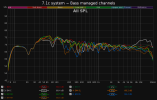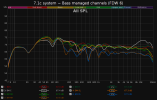Le Concombre
Active Member
- Joined
- Jul 8, 2020
- Messages
- 120
- Likes
- 34
THANK you but let me rephrase my question : it's not about the relative benefits of using FDW or non FDW but about a glitch I can't put my finger on that causes MY measurements to change slope in HF when I apply FDW to them while on the imported mdat of OCA it does notFrequency dependent windowing discards the later arriving energy that goes beyond the number of cycles chosen. In a very dry room like mine, I do not see huge changes in the response. If a lot of the sound going into the mic comes much later in time or are reflected energy, it will be removed. Vector averaging at widely spaced measurements in a room where there's a lot of reflections/time difference in arrivals also causes cancellations or loss of energy -- kind of like a comb filtering energy loss which may be more pronounced the higher up in frequency you go -- but this does not necessarily mean you aren't hearing those filtered out late arrivals -- much of it is just spaced or spread out further away from the initial transient attack. For EQing the magnitude respone, RMS averaging is normally used... unless you require/want the time/phase information. Also, prior to vector averaging measurements from the same channel/speaker, make sure that the phases or IRs are aligned.
When FDW is applied to the rears (which are very distantly positioned) of my 7.1c setup, I see a bigger reduction in magnitude compared to the fronts and sides which are at a very nearfield distance. Because of the reflections, however, they sound much louder than what the steady state curves indicate. This is why when setting up the levels and broad peak PEQs/shelving, I also use my own ears and do not just rely on how the curves look on the graphs.
BUT maybe your answer is spot on : it would not be a glitch or a setting issue but a particularity of my room (small while my speakers are big ; acquired them when I had a much bigger listening room...)
I agree with you that EQing should be done on the magnitude response, RMS averaging. But in the case of OCA, FDW keeps the general shape of the response, jus simplifies peaks and dips, so it should yield the same eQ values while he keeps time/phase information.
Last edited:













